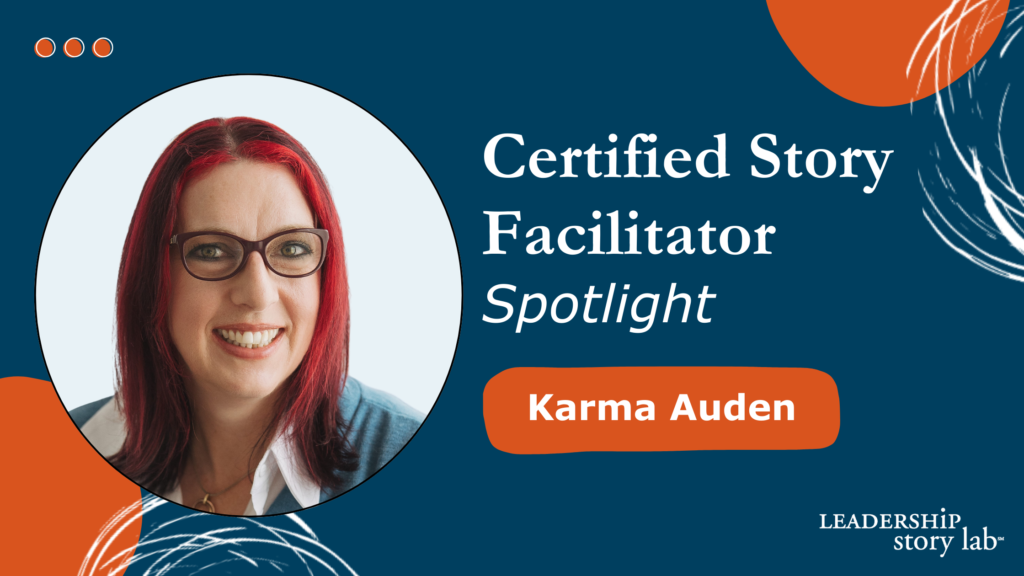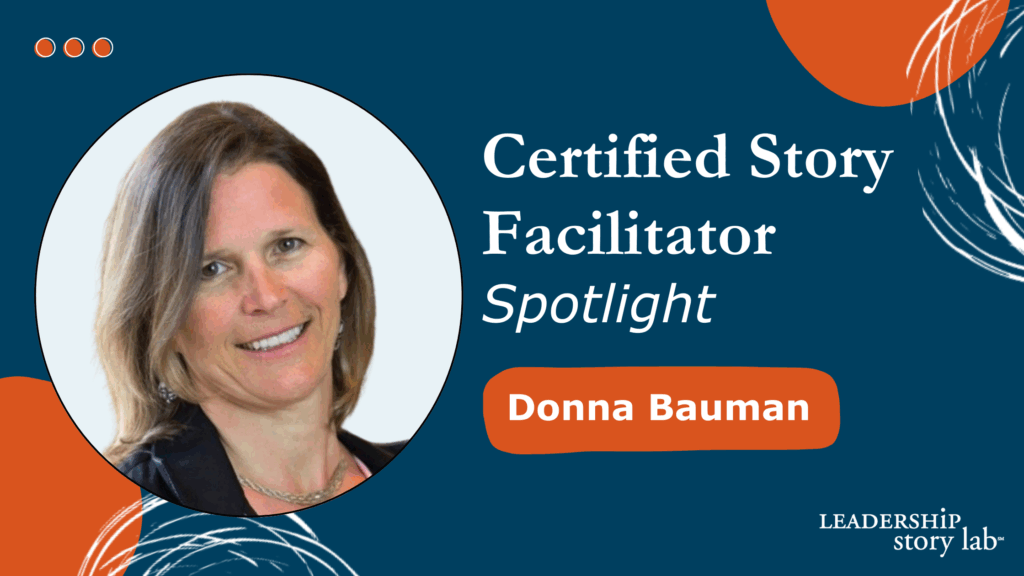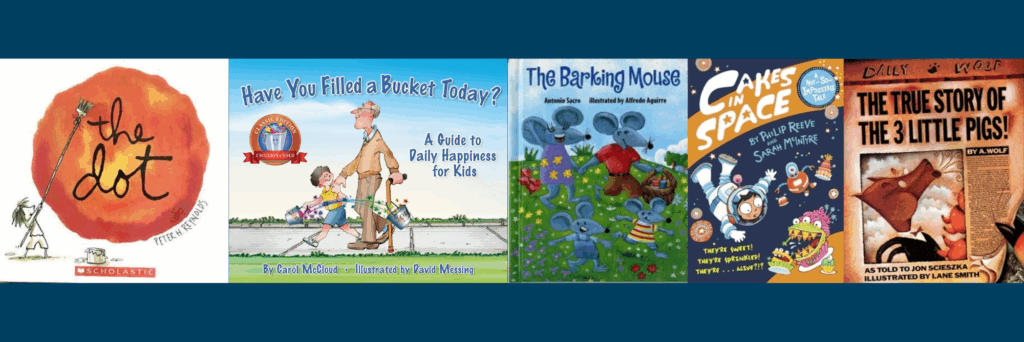February 19, 2025 / Leadership Story Lab
 20 years ago Karma Auden was working as a Business Manager for a woman who ran her own small business. Twice a year, Karma would sit down between the business owner and her accountant, and though they’d all be speaking English, Karma would have to translate for the two parties. The accountant’s jargon was meaningless to the business owner and the business owner’s questions and requests didn’t make sense to the accountant. Since then, Karma has been on a quest to turn accountants into storytellers.
20 years ago Karma Auden was working as a Business Manager for a woman who ran her own small business. Twice a year, Karma would sit down between the business owner and her accountant, and though they’d all be speaking English, Karma would have to translate for the two parties. The accountant’s jargon was meaningless to the business owner and the business owner’s questions and requests didn’t make sense to the accountant. Since then, Karma has been on a quest to turn accountants into storytellers.
Karma is now what she calls the Chief Numbers Person at the University of New England, Australia — turning numbers into stories that everyone can understand. But her quest takes her beyond her own university — she’s become the go-to expert in financial storytelling and is often asked to give keynotes, webinars and workshops on the subject for different organizations.
LSL: So what drew you to financial storytelling?
Karma: I believe that every number here is not just a number. A number represents a person or a resource or an activity. So you need to understand what that number represents in order to share the information more effectively with the business. A profit and loss statement is our version of the story because every line represents different activities, different people, different things. I’ve developed my own skill in that area and the way that I present data.
Now I’m trying to work out how to turn your everyday accountant into somebody who can do that. That’s a challenge because a lot of people who go into this profession like to sit down with 100 spreadsheets and not really talk to people at all. So it’s my quest to turn accountants into storytellers. Trying to boost their communication skills and to add real insight.
At the moment, it’s even more important because AI and tech is likely to take over a lot of the routine tasks that we do in our profession. So if a computer is going to do all the calculations and the analysis, how do we interpret that and share that with the business?
My journey through Certified Story Facilitator (CSF) training has coincided with my journey in developing and becoming known for this. I have people asking me to do a webinar on this for their finance team. It’s super exciting.
LSL: Oh, that is exciting. How did you know CSF would help you on this journey to turn accountants into storytellers?
Karma: I came across Gabrielle Dolan in Australia, who conducts a lot of storytelling and thought leader workshops. I did one of her half day storytelling workshops. Then after diving into a bit of business storytelling, which tends to come from a marketing sales standpoint, I thought there’s something here for accountants. So I was looking for something to help me help others tell better stories.
And Leadership Story Lab is really the only thing. All the other short courses help you tell stories. It’s not how you help others tell stories. And so with my quest for turning accountants into storytellers, it made sense to do this.
And even though I haven’t met anybody from CSF in person, I feel like it’s my own little family, because I’ve been around for a number of years.
Karma joined the CSF community in 2020 and she is now a Level 3 certified story facilitator. CSF offers a progressive certification model, with each level offering signature storytelling tools and areas of mastery.
-
- Level 1: Master of Story Construction. Participants learn the anatomy of stories and how to structure story ideas into appropriate formats.
-
- Level 2: Master of Story Discovery. Participants master the art of idea exploration and cultivation.
-
- Level 3: Master of Story Synthesis. Participants learn to fuse disparate narratives into one coherent whole.
LSL: What have you learned through CSF that has supported your mission to help others become better storytellers?
Karma: I think my whole financial storytelling mission has pretty much taken off since I’ve been doing CSF.
When I did the Paired Introduction for my team a number of years ago, that was the very beginning for me. That was the first time I had facilitated different groups. And it was tremendous because (A) it was great to have engagement from the team I was working with. They had a wonderful response. Really good feedback and (B) I survived. I managed to do it.
Each level of CSF trains participants in signature storytelling exercises. Paired Introductions is the exercise in CSF Level 1, focusing on active listening and the power of asking Crazy Good Questions to help write an intriguing introduction that can be used in conferences, meetings, bios and other professional and personal introduction opportunities.
Since then I’ve done a number of workshops, webinars, presentations and keynotes. As I’ve progressed, CSF has helped me become very comfortable facilitating.
When I think back to Level 1, a key learning arose from when Esther played a very difficult participant. That helps you gear up so you are prepared for anything. I’ve never come across anybody in any of my sessions that have been as difficult as Esther was in that initial training.
Unlike some conventional leadership courses, CSF goes beyond theory, and requires participants to fully immerse themselves with their own narratives and those of their peers. Similarly, participants are guided through storytelling exercises and then facilitate sessions to build these skills. Participants learn about facilitation by experiencing it in action on two levels — both as the facilitator and as a team member. And during some facilitation practices, Nancy, Esther’s lively “cousin,” shows up to keep you on your toes.
It has certainly been a journey. With each workshop I teach, I’ve gone back to understanding the basics:
- Who is my audience?
- What’s the structure of the message? How do I introduce it?
- Lastly, I am always conscious of trying to end correctly because it’s the last thing that people hear.
But the specific tool that stands out is IRS. I need to come up with my own acronym because the IRS is your tax organization. Here, we’ve got an ATO, the Australian Tax Office. So I joke I need to work out how to translate IRS into ATO.
IRS is a signature storytelling framework used in CSF to help shape brief, brilliant stories. The acronym stands for: I – intriguing beginning. R – riveting middle. S – satisfying end.
I like that there is a structure and way to think about things differently. For me, the various activities in each of the levels have really taken me out of my comfort zone too. So it’s been really interesting to step outside my day to day.
Going through the levels gave me some additional insights into what I could use in my work with the team, but the ongoing monthly sessions have been really helpful. To have the chance to jump in and remind myself of the storytelling tools we have and then carry those back to my team.
All CSFs are invited to join Leadership Story Lab’s Professional Development Series, which is a supportive community where CSFs keep learning and growing together with new ideas and frameworks during monthly calls together. Some deep dives include exploring literature and leadership, neurolinguistic programming, word play, AI, the power of great questions, among others.
In level three, I actually wrote part of my story from the perspective of my horse, which was hilarious. But it gets you thinking about how you step into other people’s shoes. Developing a better understanding of empathy has been really interesting. I’m still trying to work out how to nuance that. So that’s why this quest for accountants to be storytellers is not straightforward.
It’s going to be a continued focus for 2025. There’s a lot of work that I want to do with the finance team in my current role. Esther just rolled out Lit & Lead and I’m really excited to try that out. This is one thing I can do to start engaging my team with storytelling in a fun way.
Lit & Lead is a resource guide offered to Leadership Story Lab clients that provides the tools to host a conversation about leadership through novels, short stories or other narrative forms. With guided reflection questions about a story, each participant shares a tough leadership dilemma one of the characters faces and what they, as a reader, learned from it. The group will leave with a list of reading recommendations, but more importantly, with a chance to listen actively, share personally, and connect with their colleagues.
LSL: So let’s dig in financial storytelling. How do you turn data into a story?
Karma: It’s not like I sit down every time I start with, “Once upon a time…” It’s using certain storytelling tips and tricks. For example, can you find an anecdote or a metaphor, or other storytelling components to help engage the audience.
One of my tag lines is: “Speak like a human, not an accountant.” Get rid of all the jargon and acronyms. Keep it simple. Understand your audience. This is a key concept for storytelling. You kind of need to understand who your audience is and what is the message you want to get across.
Need help turning your financial data into a compelling story? Contact us!

Karma is an adventurer and recently traveled to Wyoming — even while on vacation she didn’t miss her CSF monthly development call.My day involves dealing with people from really diverse backgrounds. When you are presenting a budget, you’ve got to present a university budget so that the admin person down the hall can understand it, but also so that an academic who is an archaeologist who’s doing digs out in the middle of nowhere understands it as well. I find this fascinating.
When I’m presenting a budget I try to pare it back and not go into the details. I tailor the message for the audience that I’m presenting to. When I met with the University Council to sign off on the budget, that was an hour and a half session talking through the budget at quite a detailed level.
But when I was presenting the approved budget to the senior leadership team, that was probably a half hour presentation. Then the presentation at Town Hall to everybody across the university was then pared right back to 10 to 15 minutes.
I plan before each session. Who’s the audience here? What is it that they need to know? What are the key messages that they need to leave with in their head? Then tailor my message.
You can also use financial storytelling to set the emotional level. A couple of years ago, when I was going into a council presentation of the budget, it was during COVID, and I thought, I need something that gets them in the right frame of mind before I start going through my budget presentation.
Because at that moment, we didn’t know what was going on. We didn’t know if borders were going to be open or closed. And so I set the scene by saying this, “Going into this budget is a bit like driving along an unknown country road at night. You can only see as far as your headlights and you never know when a kangaroo is going to jump out.”
I thought a great deal about that story to set up the audience before heading into that presentation. All of a sudden everybody’s driving in their cars at night on a road they don’t know.
And so they got the feeling of what we were heading into. And what was great after that initial presentation, anytime we had a budget conversation, people would link it back to that story and say, “Oh, I’ve got better headlights now, I can see what’s coming.”
I wouldn’t have thought about trying to find a theme to convey a message before CSF.
LSL: Yes. It’s so fascinating to think about budgets as stories. You’ve mentioned that you are now getting asked to lead workshops for financial teams. Tell us more about that.
Karma: I delivered a financial storytelling workshop for ATEM. That stands for the Association for Tertiary Education Management. So it’s one of those industry associations that looks after professional leadership and management for the higher education sector.
I delivered a workshop called Financial Storytelling: How to Make Sense of the Numbers. I did it over two 90-minute sessions. The first one, I went through tips and tricks. Then the following month I did a drop-in follow-up session for those who wanted to come back and check in.
It was interesting because I got a really diverse mix of people attending. So I think there were about 22 people who signed up, which is actually quite good. I had some accountants, but I also had a lot of people who work in libraries and other parts of a university.
I found that fascinating. Why are people from the library side wanting to learn about financial storytelling? I thought that was really interesting. It shows that quite a lot of people are keen to turn numbers into stories. I’ve also been asked to go back and deliver another one next year which is a great sign for my quest!
I keep saying, I’m trying to make finance fun for everyone.
—
Are you looking to unlock the tools of storytelling for people in your industry? Join us for Leadership Story Lab’s signature Certified Story Facilitation training and become the go-to communications expert in your industry. The tools and insights of CSF will help you achieve that goal. The personalized feedback from Esther and your peers will help you learn how to facilitate storytelling sessions that are tailored for your specific industry.
Related Articles
Leading Your Team Through Organizational Changes: Leadership Storytelling
What Happens When You Unlock Authentic Storytelling In Corporate Trainings
Better Every Story
Leadership Transformation through Storytelling
"This is an amazing and insightful post! I hadn’t thought of that so you broadened my perspective. I always appreciate your insight!" - Dan B.
Get Esther Choy’s insights, best practices and examples of great storytelling to your inbox each month.




